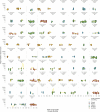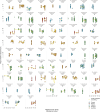Urban birds' tolerance towards humans was largely unaffected by COVID-19 shutdown-induced variation in human presence
- PMID: 39020006
- PMCID: PMC11255252
- DOI: 10.1038/s42003-024-06387-z
Urban birds' tolerance towards humans was largely unaffected by COVID-19 shutdown-induced variation in human presence
Abstract
The coronavirus disease 2019 (COVID-19) pandemic and respective shutdowns dramatically altered human activities, potentially changing human pressures on urban-dwelling animals. Here, we use such COVID-19-induced variation in human presence to evaluate, across multiple temporal scales, how urban birds from five countries changed their tolerance towards humans, measured as escape distance. We collected 6369 escape responses for 147 species and found that human numbers in parks at a given hour, day, week or year (before and during shutdowns) had a little effect on birds' escape distances. All effects centered around zero, except for the actual human numbers during escape trial (hourly scale) that correlated negatively, albeit weakly, with escape distance. The results were similar across countries and most species. Our results highlight the resilience of birds to changes in human numbers on multiple temporal scales, the complexities of linking animal fear responses to human behavior, and the challenge of quantifying both simultaneously in situ.
© 2024. The Author(s).
Conflict of interest statement
The authors declare no competing interests.
Figures








Similar articles
-
Face mask-wear did not affect large-scale patterns in escape and alertness of urban and rural birds during the COVID-19 pandemic.Sci Total Environ. 2021 Nov 1;793:148672. doi: 10.1016/j.scitotenv.2021.148672. Epub 2021 Jun 24. Sci Total Environ. 2021. PMID: 34328996 Free PMC article.
-
Rapid behavioural response of urban birds to COVID-19 lockdown.Proc Biol Sci. 2021 Mar 10;288(1946):20202513. doi: 10.1098/rspb.2020.2513. Epub 2021 Mar 10. Proc Biol Sci. 2021. PMID: 33715437 Free PMC article.
-
Escape behaviour of birds in urban parks and cemeteries across Europe: Evidence of behavioural adaptation to human activity.Sci Total Environ. 2018 Aug 1;631-632:803-810. doi: 10.1016/j.scitotenv.2018.03.118. Epub 2018 Mar 16. Sci Total Environ. 2018. PMID: 29727990
-
The COVID-19 pandemic: Impacts on cities and major lessons for urban planning, design, and management.Sci Total Environ. 2020 Dec 20;749:142391. doi: 10.1016/j.scitotenv.2020.142391. Epub 2020 Sep 18. Sci Total Environ. 2020. PMID: 33370924 Free PMC article. Review.
-
The global epidemic of SARS-CoV-2 variants and their mutational immune escape.J Med Virol. 2022 Mar;94(3):847-857. doi: 10.1002/jmv.27376. Epub 2021 Oct 13. J Med Virol. 2022. PMID: 34609003 Free PMC article. Review.
Cited by
-
Integrating human mobility and animal movement data reveals complex space-use between humans and white-tailed deer in urban environments.Sci Rep. 2025 May 28;15(1):18588. doi: 10.1038/s41598-025-03577-5. Sci Rep. 2025. PMID: 40425680 Free PMC article.

